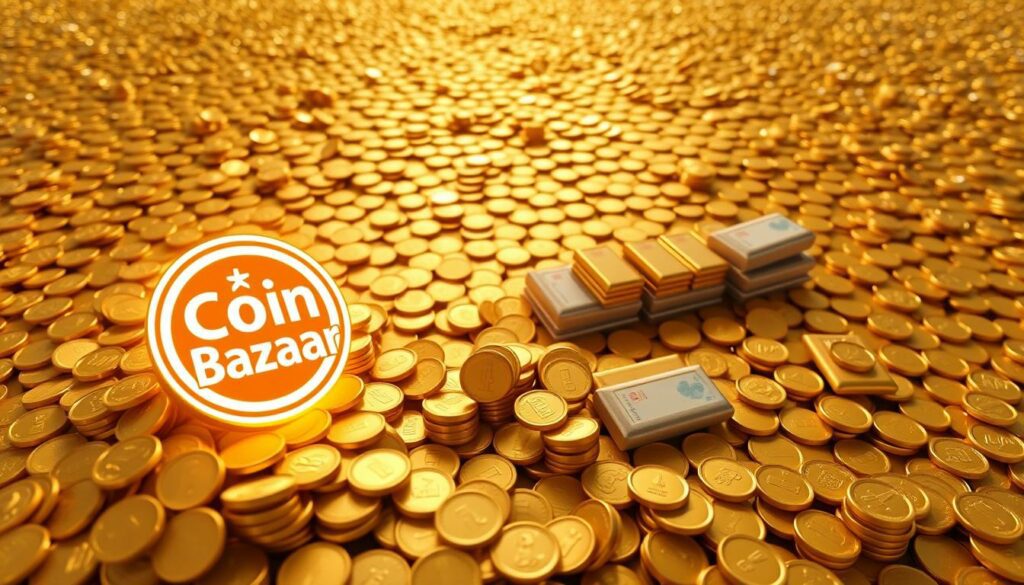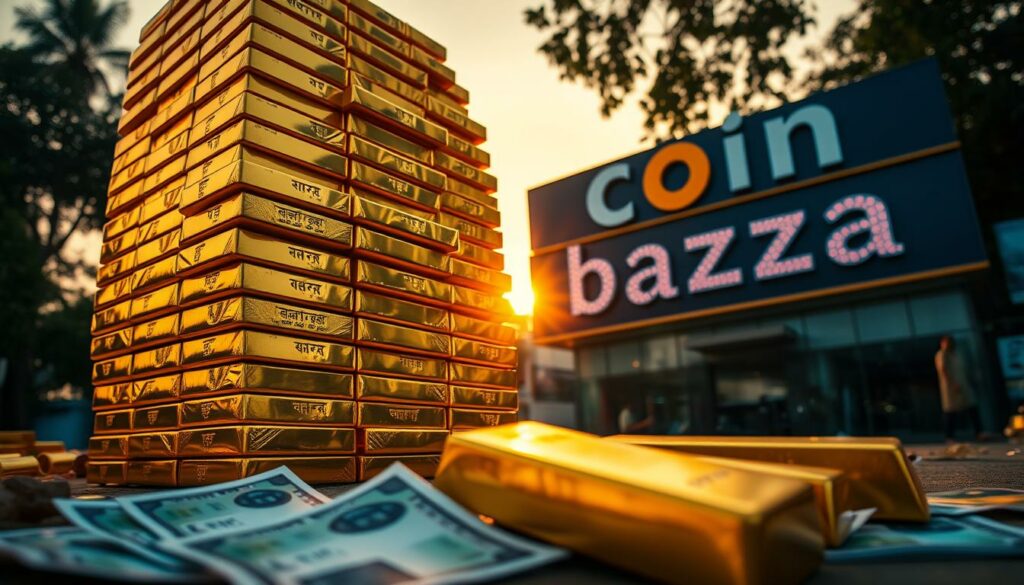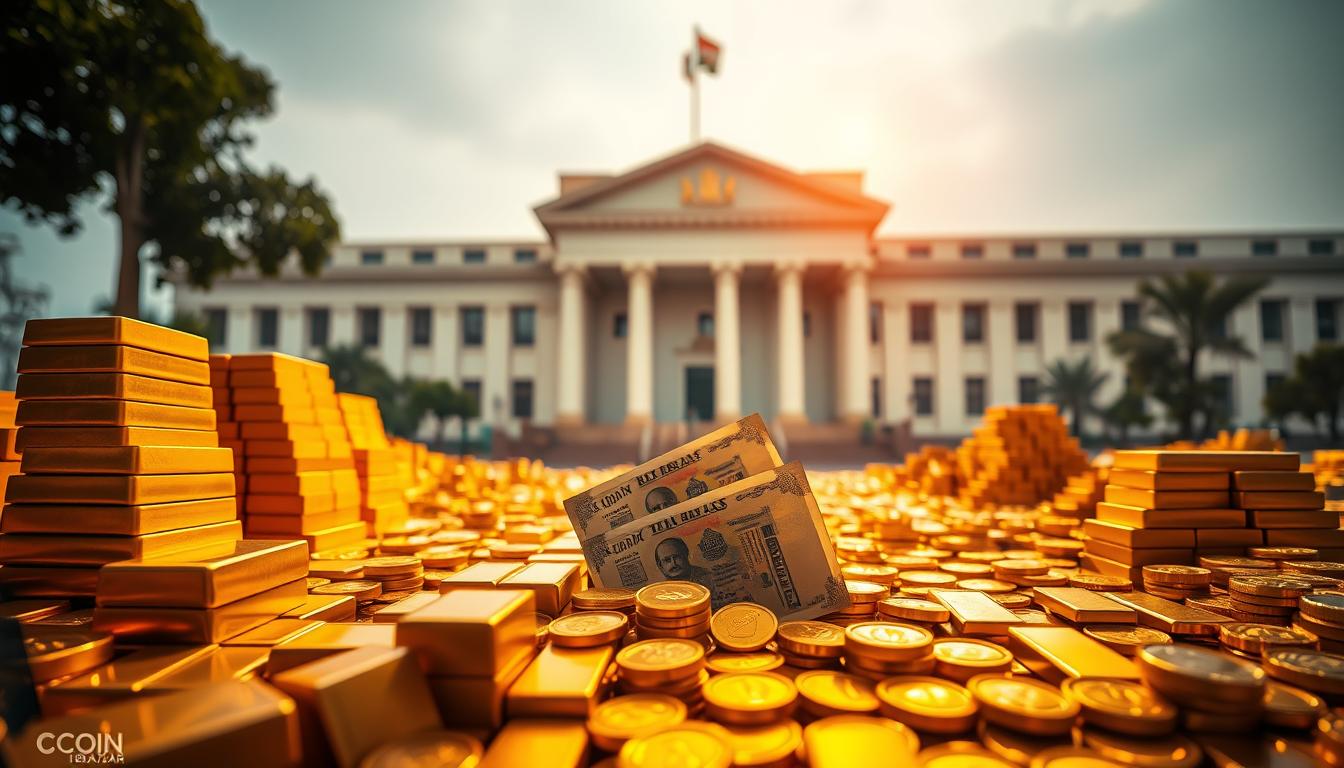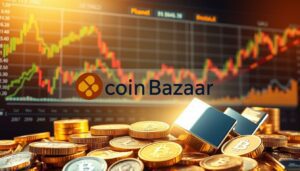Exclusive Deals & Trending Items


Muthoot Pappachan Swarnavarsham Gold Hallmarked Rose Coin of 1 gms in 22 KT 916 Purity Fineness
Shop Now

Muthoot Pappachan Swarnavarsham Gold Hallmarked Rose Coin of 5 gms in 22 KT 916 Purity Fineness
Shop Now

MMTC PAMP Silver Coin Laxmi Ganesh of 10 Gram in 999.9 Purity in Certicard & Capsule as per availability/Fineness
Shop NowYou’ve likely heard that central banks have been buying a lot of gold reserves. In 2024, they added 1,045 tons to their collections. This is the 15th year in a row they’ve made these purchases.
This trend is more than just a number. It has big implications for economic stability around the world. As we look at global economies, it’s key to understand the role of gold reserves. Their impact on financial markets is very important.
The ongoing purchases by central banks show a big change in how the world handles its economy. It might mean a shift in how assets are managed globally.
Key Takeaways
- Central banks have purchased 1,045 tons of gold in 2024.
- This marks 15 consecutive years of gold buying by central banks.
- The trend has significant implications for global economic stability.
- Understanding gold reserves is crucial for grasping global economic dynamics.
- The shift in gold reserves may indicate a rebalancing of global assets.
The Global Surge in Central Bank Gold Purchases
The global economy is seeing a big change as central banks buy more gold. This move is changing the market and how we invest in precious metals. Expect to see more gold in central banks’ reserves as they diversify.
Recent Statistics and Growth Patterns
In 2024, the National Bank of Poland bought 90 tons of gold, leading the trend. This shows a clear growth in gold purchases by central banks. They are buying gold to ensure economic stability and diversify their investments.
Key statistics include:
- A big increase in gold reserves by emerging market banks.
- A shift in monetary policy, with gold becoming more important.
- Gold purchases are growing steadily, showing a long-term trend.
Key Central Banks Leading the Gold Buying Spree
Several key central banks are leading the gold buying trend. The National Bank of Poland’s big purchase in 2024 set a new standard. Expect more central banks to add to their gold reserves, making this trend even stronger.


As the World Gold Council says, “Central banks are increasingly turning to gold as a safe-haven asset, driving up demand and prices.” This quote shows how important gold is in today’s economy.
Historical Context: Gold’s Role in Central Banking
Gold has been key in central banking for centuries. It has been a base for money systems. Its role has changed a lot, due to history and economic changes.
The Gold Standard Era
In the gold standard era, money was tied to gold’s value. This system kept economic stability by stopping governments from printing too much money. It helped control inflation.
The gold standard was used a lot in the 19th and early 20th centuries. It made international trade easier by keeping exchange rates stable.
But, the gold standard had its downsides. It made it hard for governments to help the economy during tough times. The Great Depression was a key moment. Countries then left the gold standard to use new money policies.


Transition to Modern Monetary Systems
After the gold standard fell apart, fiat currency systems took over. These systems value money based on government rules, not physical things. This change made money policies more flexible.
Even though we moved away from the gold standard, gold is still important. It helps with reserve asset diversification for central banks. It helps keep economic stability when times are uncertain.
Today, central banks keep gold to protect against economic ups and downs. This shows gold’s lasting value in our money systems.
Why Central Banks Are Accumulating Gold Now
Central banks around the world are buying gold at a record pace. This is due to a mix of economic factors. It’s not just a quick response to market changes but a thoughtful strategy.
Economic Uncertainty Drivers
Economic uncertainty is a big reason for central banks to buy gold. Issues like global trade tensions, currency fluctuations, and the COVID-19 pandemic make them look for safe assets. Gold is seen as a reliable value store.
Geopolitical tensions and the risk of sudden economic shocks add to the complexity. In this setting, central banks are spreading out their reserves. Gold helps protect against inflation and market ups and downs.
De-dollarization Efforts
Central banks are also buying gold to reduce their dollar dependence. This move is part of a plan to use other assets, like gold, instead of the US dollar. It’s a response to worries about the dollar being used as a political tool.
By adding gold to their reserves, central banks aim to lessen dollar-related risks. This helps diversify their portfolios. It’s a step towards a more balanced currency system, with gold at its core.
Portfolio Diversification Strategy
Gold is also part of a broader strategy for central banks. It helps balance their reserves by adding a different asset class. Gold’s low link to other financial assets makes it a good diversifier.
This diversification is key to managing risks from other assets, like foreign currencies and bonds. As the global economy gets more complex, gold becomes a smart choice for central banks. It makes their reserve portfolios more resilient.
The Mechanics of Central Bank Gold Purchases
Central banks are buying more gold, which has sparked interest in how they do it. You might be curious about the steps involved and how these actions affect the world economy.
Acquisition Methods and Sources
Central banks get gold in different ways. They buy it from the open market or other banks. They also get gold through over-the-counter (OTC) deals or from gold mining companies. The World Gold Council says central banks have been buying gold for years, boosting their reserves a lot.
| Acquisition Method | Description | Frequency |
|---|---|---|
| Open Market Purchases | Buying gold directly from the market | High |
| OTC Transactions | Direct transactions with gold dealers or other banks | Moderate |
| Gold Mining Companies | Purchasing gold directly from mining companies | Low |
Storage and Management Practices
After buying gold, central banks must store it safely. They often keep it in vaults, either at home or in secure places abroad, like the Bank of England. Keeping gold safe, real, and easy to use is key. As the World Gold Council points out, “The security and integrity of gold reserves are paramount.”
“Gold is a unique asset that provides a level of security and liquidity that is hard to match with other assets.”
Impact on Global Gold Prices and Supply
Central banks’ growing interest in gold is changing the game for global gold prices and supply. Their large-scale gold buying is reshaping the global gold market.
Price Movements Following Major Purchases
Central banks’ big gold buys have a big impact on global gold prices. When they buy gold, it boosts demand and prices. For example, when central banks buy more, gold prices often go up.
These consistent buys also make the market more predictable. This predictability affects how investors act, which in turn changes prices. So, knowing what central banks do with gold is key for investors.
Supply Chain Implications
Central banks’ demand for gold also affects the gold supply chain. Their need for more gold means more demand for physical gold. This can cause supply shortages in some markets.
This increased demand impacts everyone from miners to manufacturers. They must adapt to the new situation. The need for secure storage and management adds to the complexity, requiring advanced logistics and security.
Geopolitical Implications of Gold Reserve Shifts
The global gold reserve shift is changing the world’s politics. As countries add gold, their relationships with each other are evolving. Gold is now a key player in how nations interact.
Power Dynamics Between Gold-Holding Nations
Gold reserves are changing who has power in the world. Nations with lots of gold get more economic and political strength. This is especially true when the world economy is shaky, and gold is seen as a safe place to put money.
Gold is now a big part of international talks and deals. Countries with lots of gold are becoming more influential. This could change how the world is run economically.
Regional Alliances and Gold Policies
Gold reserves are also affecting regional groups. Countries in a region might follow the same gold policies. This could make their economic bonds stronger.
For example, BRICS nations are looking to use less US dollars. Gold is a big part of this plan. This could lead to a world with more separate economic areas, each led by a strong gold holder. Such changes could affect many things, from economic plans to international relations.
India’s Position in the Global Gold Reserve Landscape
India’s role in the global gold reserve landscape is growing. The country’s gold reserves are increasing. The Reserve Bank of India (RBI) is key to this growth.
Reserve Bank of India’s Gold Strategy
The Reserve Bank of India has been buying gold. By the end of 2024, it had 876 tons. This move is to diversify foreign exchange reserves and boost economic stability.
Comparison with Other BRICS Nations
India’s gold reserves are notable, especially when compared to BRICS nations. Countries like China and Russia also buy gold. But India’s reserves stand out due to its unique economic and cultural factors.
Cultural Significance of Gold in Indian Economy
Gold is very important in India, for both cultural and economic reasons. People buy gold for jewelry and cultural practices, not just for investment. The RBI’s gold buying strategy fits with this cultural importance, making gold a key part of India’s economy.
How Central Bank Gold Purchases Affect Your Investments
Central banks buying gold changes how investors should plan. They need to think about how to make more money and avoid losing it. Knowing what central banks do with gold is key to smart investing.
Impact on Gold ETFs and Mutual Funds
Gold ETFs and mutual funds can be affected by central banks’ gold buying. When central banks buy gold, more people want it. This can make gold prices go up, which can help the value of these investments.
Popular Gold Funds in India
Some top gold funds in India are:
- Gold ETFs: These funds buy gold and trade on stock exchanges. They make it easy to invest in gold.
- Gold Mutual Funds: These funds put money into gold-related things like ETFs or mining stocks. They offer a way to get into the gold market with a mix of investments.
Performance Correlation with Central Bank Activities
The success of gold ETFs and mutual funds can tie to what central banks do. If central banks buy gold, prices might go up. This can make these funds more valuable. But, other things in the market can also affect how well they do.
Implications for Physical Gold Ownership
Buying physical gold can get pricier when central banks buy more. But, if you already own gold, its value might go up. This is because more people want it.
Investors should think about their whole plan and how gold fits into it. Keeping an eye on market trends is also important. This helps them adjust their investments wisely.
Currency Stability and Gold Reserves Correlation
The link between a country’s gold reserves and its currency stability is very interesting. Countries with lots of gold reserves usually have more stable currencies. This is because gold is seen as a safe place to put money.
Case Studies of Currency Strength Tied to Gold Reserves
Many countries show a strong link between their gold reserves and currency strength. For example:
- Switzerland: With a lot of gold reserves, Switzerland’s currency, the Swiss Franc, is very stable.
- United States: The U.S. has a lot of gold, and the USD is a global reserve currency, known for being stable.
These examples show how gold reserves help keep currencies stable.
Implications for the Indian Rupee
For India, having the right amount of gold reserves is key for the Rupee’s stability. The Reserve Bank of India (RBI) watches its gold purchases closely. This can affect the Rupee’s value against other currencies.
Having a strong gold reserve can make investors trust the Rupee more. This could lead to a more stable currency. So, the RBI’s gold reserve strategy is very important for the Rupee’s performance.
Economic Stability Indicators Related to Gold Reserves
Gold reserves are crucial for economic stability, especially in tough financial times. They act as a shield against economic shocks. This is why central banks stock up on gold, seeing it as a strategic asset for navigating economic ups and downs.
Inflation Protection Mechanisms
Gold reserves are a key tool against inflation. When inflation goes up, the value of regular money goes down. But gold’s value often goes up, making it a good hedge against inflation. This is why central banks add gold to their reserves to protect against inflation’s effects.
- Gold’s history shows it’s a reliable hedge against inflation.
- Central banks buy more gold when the economy is uncertain.
- Adding gold to reserves can lower a nation’s risk.
Crisis Resilience Patterns
Gold reserves also show strong crisis resilience patterns. They act as a safe-haven asset during financial crises. Gold usually keeps its value or even goes up, helping to keep the economy stable. This is a big reason why central banks choose to hold gold reserves.
“Gold is often seen as a safe-haven asset, and its role in central banks’ reserve management is crucial during times of economic uncertainty.”
By holding gold, central banks can reduce losses in other assets during a crisis. This boosts the overall resilience of their economies.
Investment Strategies for Indian Investors
As an Indian investor, you might want to add gold to your portfolio. Central banks are buying gold fast, which affects your investment plans. This section will guide you on how to diversify, including the best ways to invest in gold in India.
Portfolio Allocation Recommendations
Diversifying your portfolio is key to managing risks and increasing returns. Gold is a good addition to your investments. The right amount of gold in your portfolio depends on your goals, how much risk you can take, and when you plan to cash out. A common advice is to put 5-10% of your portfolio in gold.
This can help you stay stable during market ups and downs. Gold is known for being a safe place to put your money.
Gold Investment Options in India
In India, you can invest in gold in different ways. These include digital gold, physical gold, and sovereign gold bonds. Each option has its own pros and cons.
Digital Gold: Digital gold lets you invest in gold without needing to store it physically. It’s easy and cost-effective. But, make sure to pick a reliable platform to avoid risks.
Physical Gold: Physical gold, like coins or bars, is a real asset. But, it needs safe storage and comes with making charges and other costs.
Digital Gold vs. Physical Gold
Choosing between digital and physical gold depends on what you want. Digital gold is convenient and easy to deal with. Physical gold gives you a real item. Mixing both can be a smart strategy.
Sovereign Gold Bonds and Gold Monetization Schemes
Sovereign Gold Bonds (SGBs) are special investments from the Government of India. They offer a fixed return and the chance for gold to appreciate. They’re good for those seeking a safe investment. Gold Monetization Schemes let you deposit gold with banks and earn interest. These schemes can turn your unused gold into income.
| Investment Option | Advantages | Disadvantages |
|---|---|---|
| Digital Gold | Convenient, cost-effective | Potential risks if not chosen carefully |
| Physical Gold | Tangible asset | Requires secure storage, making charges |
| Sovereign Gold Bonds | Fixed return, relatively safe | Limited liquidity |
| Gold Monetization Schemes | Earn interest on gold deposits | May have certain conditions and restrictions |
Tax Implications for Gold Investments
Knowing the taxes on gold investments is key to getting the most out of them. In India, capital gains tax applies to gold investments. The tax rate varies based on how long you hold the gold and the type of investment. It’s wise to talk to a tax expert to understand the taxes on your gold investments.
Future Projections for Central Bank Gold Purchases
Central banks are likely to keep buying gold in the future. This is because economic uncertainty is still high. They see gold as a safe asset to hold.
As the world faces economic challenges, gold’s role in central banks’ reserves is set to grow. Experts predict that central banks will keep buying gold. They need it for diversification and as a safety net against economic ups and downs.
Expert Forecasts and Trend Analysis
Experts say central banks will keep buying gold. They want to spread out their risks and ensure economic stability. A World Gold Council report shows central banks will likely keep buying gold in the future.
Gold’s appeal is also boosted by de-dollarization efforts and a desire to not rely too much on one currency. So, gold will likely stay a key part of central banks’ strategies for managing their reserves.
“Central banks’ gold purchases are expected to continue as they seek to diversify their reserves and mitigate potential risks associated with currency fluctuations.”
Potential Disruptors to Current Patterns
But, there could be things that change this trend. For example, big changes in global economic policies or the rise of digital currencies could affect gold buying.
Also, changes in gold prices or problems in the supply chain could influence central banks’ decisions. It’s important to watch these potential disruptors to understand their impact on gold purchases.
- Economic policy changes
- Rise of digital currencies
- Gold price volatility
- Supply chain disruptions
The Role of Gold in a Changing International Monetary System
With digital currencies on the rise, we wonder: what’s gold’s future in global finance? It’s key to grasp how gold and digital currencies interact in this changing world.
Digital Currencies vs. Traditional Gold Reserves
Digital currencies have brought up questions about gold’s place. Gold has always been a stable store of value. Yet, central banks keep adding to their gold reserves, showing its lasting value.
Let’s look at how digital currencies and gold reserves differ:
| Characteristics | Digital Currencies | Gold Reserves |
|---|---|---|
| Store of Value | Volatile | Stable |
| Liquidity | High | High |
| Intrinsic Value | No | Yes |
Emerging Frameworks for Global Finance
New financial systems are coming, which might change gold’s role. These include international monetary cooperation and new financial tools that use gold.
These new systems could make gold even more important in global finance. They might show gold’s value alongside digital currencies.
Conclusion
Central bank gold purchases have big effects on the world economy. They are driven by uncertainty, efforts to reduce the dollar’s power, and diversifying portfolios. It’s key for investors and leaders to understand these reasons.
The increase in gold reserves impacts the global gold market and currency stability. For investors in India, this trend brings both chances and challenges. It affects how they plan their investments and manage their portfolios.
Gold’s role in the international monetary system is set to stay important. Central banks keep buying gold, showing its value as a safe asset. This trend will likely keep shaping the global economy in significant ways.


















One Response
It’s fascinating to see central banks consistently adding to their gold reserves year after year. This long-term trend could be signaling a bigger shift in how global economies are preparing for financial instability, especially with inflation and geopolitical tensions on the rise.